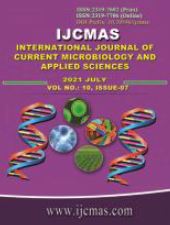


 National Academy of Agricultural Sciences (NAAS)
National Academy of Agricultural Sciences (NAAS)

|
PRINT ISSN : 2319-7692
Online ISSN : 2319-7706 Issues : 12 per year Publisher : Excellent Publishers Email : editorijcmas@gmail.com / submit@ijcmas.com Editor-in-chief: Dr.M.Prakash Index Copernicus ICV 2018: 95.39 NAAS RATING 2020: 5.38 |
A field experiment was conducted for four consecutive years during Kharif season of 2009, 2010, 2011 and 2012 to access the suitable methods (dry sowing, transplanting of 25 days aged seedlings and farmers practice) of planting at varied planting geometries (120 x 90 cm and 90 x 20 cm) in medium vertisols, under rainfed conditions at Regional Agricultural Research Station Vijayapur. The results revealed that significantly higher grain yield (1805 kg ha-1) of Pigeonpea was recorded with dry sowing (T1) at 120 x 90 cm on June first week and which was found to be at par with the raising of seedlings (T4) on first June in poly bags and transplanting at 120 x 90 cm after receipt of good rainfall (1736 kg ha-1). Significantly lowest gain yield (1372 kg ha-1) was noticed in recommended practice i.e., sowing after receipt of good rainfall at 90 x 20 cm on flat bed (farmers practice). The rainfall received during first week of June 2009, 2010, 2011 was more favorable for advancing crop growth and development when pigeonpea was sown in dry method compared with farmers practice i.e., crop sown after receipt of good rainfall. The extent of yield increase with dry sown method (T1) was 3.82% and 23.99% over transplanting of 25 days aged seedlings at 120 x 90 cm (T4) and recommended practice i.e., crop sown after receipt of good rainfall at 90 x 20 cm on flat bed method (T5), respectively. Number of pods plant-1 were significantly higher in 120 x 90 cm with transplanting method (635 plant-1) and was at par with that of dry sown method (581 plant-1) compared to recommended practice i.e., sowing at 90 x 20 cm (196 plant-1). The gross (` 64426 ha-1) and net returns (` 46960 ha-1) were significantly higher in dry sowing at 120 x 90 cm on June first week. The next best treatment was transplanting (T4) of 25 days old seedlings at 120 x 90 cm after receipt of good rainfall when compared to rest of the treatments. The farmers practice (90 x 20 cm) recorded significantly lowest gross return (`45862 ha-1) and net returns (`32536 ha-1). Significantly higher BC ratio of 3.84 was recorded in dry sown (120 x 90 cm) crop followed by sowing after receipt of good rainfall at 120 x 90 cm while the transplanted treatment recorded lower BC ratio of 2.89, though transplanting of 25 days aged seedlings recorded favorable parameters like number of pods plant-1, number of branches plant-1 and dropped leaf litter per square meter area but the cost of cultivation involved in raising of seedlings in poly bags and transplanting to the main field required higher number of labour per unit area when compared with dry sown method.
 |
 |
 |
 |
 |